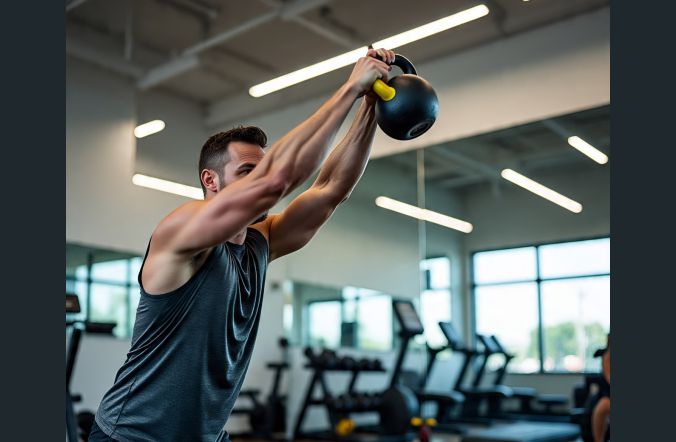Last updated on November 7th, 2025 at 05:50 am
Men’s fitness builds strength, sharpens health, and fuels confidence. This guide from Gentsways gives insight into training, nutrition, and mindset strategies every man needs to reach peak performance.
Men’s fitness goes beyond lifting weights or chasing a number on the scale.
It is about building strength you can feel, health you can depend on, and confidence that follows you into every part of life.
When you commit to training, you do more than change your body, you reshape the way you live.
From preventing chronic conditions like diabetes and heart disease to sharpening focus and easing stress, fitness touches every corner of your well-being.
Strength training, nutrition, recovery, and lifestyle choices work together as the foundation of lasting health.
This guide takes you through those pillars step by step. No matter your age or starting point, you will find the tools to train with purpose and keep progressing.
Recommended: Men’s Health and Wellness Guide
Table of Contents
- What is Fitness?
- The Importance of Fitness in Men’s Health
- Core Pillars of Men’s Fitness
- Cardiovascular Training for Men
- Flexibility and Mobility in Men’s Fitness
- Nutrition for Men’s Fitness
- Recovery and Sleep in Men’s Fitness
- Age-Specific Fitness for Men
- Mental Fitness and Mindset in Men
- Lifestyle Factors Influencing Men’s Fitness
- Training Programs and Approaches for Men
- Common Fitness Challenges Men Face
- Conclusion
- Frequently Asked Questions
What is Fitness?
Fitness is your body’s ability to perform daily tasks with strength, endurance, and flexibility while maintaining good health.
It is not limited to muscles or appearance but includes cardiovascular health, mobility, balance, and recovery.
True fitness means having the energy to handle work, family, and recreational activities without fatigue, while also reducing the risk of chronic diseases.
It blends exercise, nutrition, rest, and lifestyle choices into a balanced system that supports both physical and mental well-being.

The Importance of Fitness in Men’s Health
Your health depends on more than medical checkups. Fitness gives you the strength, energy, and resilience needed to face daily challenges while lowering the risks of long-term health problems.
Fitness and Cardiovascular Health
When you exercise regularly, your heart grows stronger, your circulation improves, and your stamina increases.
Activities like running, cycling, and strength training keep your blood pressure steady and cholesterol in check.
This lowers the risk of cardiovascular disease, which remains a leading threat to men’s health.
A healthier heart also means more energy for work, family, and personal goals without constant fatigue.
Fitness as Disease Prevention
Regular physical activity plays a vital role in keeping weight under control and regulating blood sugar.
This protects you from conditions like type 2 diabetes and metabolic syndrome.
Structured training improves insulin sensitivity and supports healthier cholesterol levels.
These changes lower the chances of chronic disease while giving you more control over your long-term health outcomes.
Prevention starts with consistency in movement and smart lifestyle choices.
Fitness and Testosterone Levels
Exercise directly supports hormone balance. Strength training and high-intensity workouts stimulate testosterone, which helps build muscle mass, protect bone density, and sustain energy.
Healthy testosterone levels improve physical performance, boost mental focus, and support mood stability.
By training consistently, you create an environment where your body produces the hormones needed for vitality, strength, and sharper mental clarity.
This makes fitness a natural way to support men’s health at every stage of life.
Fitness and Mental Well-Being
Training is not only for your body, it shapes your mind.
Exercise reduces stress, lifts mood, and helps manage anxiety and depression. Movement triggers endorphins, which act as natural mood boosters.
A consistent routine improves confidence and creates a sense of control over your life.
Better mental health motivates you to keep showing up, creating a cycle where fitness strengthens both your body and emotional resilience.
Recommended: Older Men’s Fitness Guide
Core Pillars of Men’s Fitness
Your fitness journey rests on specific pillars that build strength, improve health, and give you lasting energy.
These foundations shape a balanced routine that works in real life.
Strength and Resistance Training

Strength training is the backbone of men’s fitness because it supports muscle growth, bone health, and testosterone levels.
It improves how your body performs in both sports and everyday tasks. You do not have to start with heavy lifting.
Simple moves like squats, push-ups, and pull-ups create a solid foundation of strength.
In the long run, you can introduce barbells, dumbbells, or machines to challenge your body further.
This type of training is about building lasting power, reducing injury risk, and creating the resilience needed for long-term health and physical independence.
Bodyweight Exercises

Bodyweight exercises remain one of the most accessible forms of strength training for men.
They require no equipment, making them easy to perform at home or while traveling.
Push-ups, squats, planks, and pull-ups target multiple muscle groups, which helps you build strength, balance, and stability.
These movements improve coordination and mobility, both of which are necessary for better performance in daily life.
As you progress, variations such as single-leg squats or weighted push-ups keep your body challenged.
Bodyweight training also supports fat loss by engaging large muscles and burning calories, making it an effective starting point for fitness at any level.
Free Weights and Gym Machines

Free weights and machines give you structure and variety in your fitness routine.
Dumbbells and barbells strengthen muscles while improving balance and coordination since you must stabilize the load yourself.
Gym machines, on the other hand, guide your movements, allowing you to safely target specific muscles without worrying much about form.
This is especially helpful when you are new to training or recovering from injury.
Combining both approaches creates well-rounded strength, allowing you to train different muscles safely while still gaining functional power.
Together, they provide flexibility in workouts and help you progress at a pace that feels sustainable.
Functional Strength Movements

Functional training makes your strength practical by mimicking the movements you use every day.
Kettlebell swings, medicine ball throws, farmer carries, and lunges train multiple muscles at once while improving balance, stability, and coordination.
These exercises prepare your body for real-life tasks like lifting, bending, or carrying loads without injury.
Functional strength also supports athletic performance by developing power and endurance.
By engaging the core and stabilizing muscles, these movements protect your spine and joints.
Including functional exercises in your routine ensures your training is not limited to aesthetics but supports a stronger, more capable body in the long run.
Related Posts
How Testosterone Supports Muscle Health and Growth
Older Men’s Functional Fitness Routine
Guide to Testosterone: Everything to Know
Cardiovascular Training for Men

Cardio training strengthens your heart, builds endurance, and supports overall fitness.
By mixing different methods, you can manage weight, boost energy, and keep workouts challenging and enjoyable.
Steady-State Cardio
Steady-state cardio keeps your body moving at a consistent pace for longer periods.
Activities such as running, cycling, swimming, or rowing improve aerobic capacity and help manage body fat.
This method trains your heart to pump blood more efficiently, which improves stamina for work, sports, and everyday life.
It is also easier to sustain regularly since the pace is steady and controlled.
Steady-state cardio works well when paired with strength training, giving you balance between endurance and power while keeping your energy levels stable throughout the day.
High-Intensity Interval Training
High-intensity interval training alternates short bursts of maximum effort with recovery periods.
For example, you might sprint for 30 seconds, then walk for one minute before repeating.
HIIT sessions are shorter than steady-state workouts but deliver faster results in calorie burn and cardiovascular fitness.
This method challenges both your aerobic and anaerobic systems, making your heart, lungs, and muscles adapt more efficiently.
It is especially effective for fat loss while preserving muscle mass.
HIIT also fits well into busy schedules since it delivers measurable benefits in less time while keeping training sessions engaging and dynamic.
Circuit Training
Circuit training combines resistance exercises with cardiovascular movements performed back-to-back.
A session might include push-ups, kettlebell swings, burpees, and jump squats with minimal rest between sets.
This format keeps your heart rate elevated while strengthening muscles across the body.
It improves endurance, coordination, and functional strength, which translates into better performance in sports and daily activities.
Circuit training is time-efficient, offering both cardio conditioning and strength development in one workout.
By varying the exercises, you can target different muscle groups and prevent monotony, making it a practical option for men seeking all-around fitness progress in a limited time.
Recommended Frequency
Cardio results depend on consistency. Aim for 150 minutes of moderate-intensity aerobic activity each week, such as jogging or cycling, or 75 minutes of vigorous training, such as sprint intervals or intense circuits.
Splitting your sessions across the week improves recovery while keeping progress steady.
Combining steady-state cardio with HIIT and circuit workouts prevents plateaus and challenges your body in multiple ways.
This variety keeps training interesting while ensuring balanced development in stamina, endurance, and heart health.
The key is finding a mix you enjoy and committing to it regularly for long-term cardiovascular fitness and overall well-being.
Flexibility and Mobility in Men’s Fitness

Your body is designed to move freely. Flexibility and mobility give you a better range of motion, protect you from injuries, and help you perform stronger in daily life and workouts.
Why Flexibility Matters
When you skip flexibility training, your muscles tighten and restrict movement.
This makes weightlifting, running, or even simple daily tasks harder on your body.
Stretching improves posture, reduces tension, and supports athletic performance.
By working on flexibility, you allow your muscles to move without resistance, which prepares your body for strength training and cardio.
Think of flexibility as the foundation that keeps every other part of your fitness routine safe and effective.
Mobility for Daily Strength
Mobility is about how well your joints move under control.
Without it, your body compensates with poor mechanics that lead to pain or injuries.
Focusing on mobility makes squats deeper, pushes smoother, and running less stressful on your joints.
Simple drills like leg swings, arm circles, or hip openers warm up your body before workouts and keep your joints healthy.
When you train mobility consistently, you move with greater ease in both exercise and everyday life.
Injury Prevention Through Movement
Tight muscles and stiff joints force your body to work against itself.
With time, this leads to strains, sprains, and nagging aches that limit your training progress.
By adding stretches and mobility drills, you lower the chances of injury while preparing your body for harder workouts.
Think of it as building a shield around your muscles and joints.
Strong mobility keeps your body balanced and resilient, so you can keep training without setbacks.
Stretches You Can Start With
You don’t need special equipment to begin improving flexibility and mobility.
Daily moves like the hip flexor stretch, hamstring stretch, and spinal twist open up stiff areas quickly.
Pair them with dynamic drills like lunges with a twist or torso rotations to activate muscles before lifting or running.
These stretches keep your muscles loose, your joints moving smoothly, and your body ready for the demands of training.
Practicing them consistently makes workouts safer and progress faster.
Nutrition for Men’s Fitness

The food you eat directly shapes your strength, recovery, and energy.
A balanced diet supports training, builds muscle, and fuels you to perform better in and out of the gym.
Protein for Muscle Repair
Protein helps your body repair and build muscles after workouts.
Without enough protein, your recovery slows, and strength gains stall.
Focus on lean sources like chicken, turkey, fish, eggs, dairy, beans, and lentils.
Spread your intake across meals instead of eating it all at once.
This steady supply ensures your muscles have what they need throughout the day, helping you maintain growth and reduce soreness after training.
Carbohydrates for Energy
Carbohydrates are your body’s main energy source, especially during intense exercise.
Choosing complex carbs like oats, brown rice, sweet potatoes, fruits, and vegetables keeps your energy steady.
They prevent the crashes you feel with processed sugar or refined grains.
Eating carbs before training prepares your muscles with glycogen, while post-workout carbs help refill those stores.
This balance keeps you energized for both exercise and daily responsibilities.
Healthy Fats for Recovery
Fats support hormone production, joint health, and recovery.
Instead of avoiding them, choose healthy fats from foods like salmon, mackerel, walnuts, chia seeds, olive oil, and flaxseeds.
Omega-3 fatty acids, in particular, fight inflammation caused by heavy training, reducing stiffness and soreness.
Adding small amounts of these fats to your meals not only supports recovery but also keeps your body functioning smoothly. They work best when balanced with protein and carbs.
The Role of Micronutrients
Vitamins and minerals keep your body running at its best. Magnesium supports muscle function and energy use, while vitamin D strengthens bones and boosts immunity.
Zinc aids testosterone production, which influences strength and endurance.
You can get these nutrients from leafy greens, nuts, seeds, lean meats, and sunlight.
Skipping them leaves your body vulnerable to fatigue and slow recovery.
Keeping your diet varied ensures no key nutrient is missing.
Timing Your Meals
When you eat matters as much as what you eat. A pre-workout snack with carbs and protein gives you fuel and focus during training.
After your workout, a balanced meal with lean protein and slow-digesting carbs repairs muscle and restores energy.
Even spacing meals throughout the day keeps your metabolism steady and your body ready for both exercise and recovery.
Consistency in timing maximizes the impact of your diet.
Supplements for Support
Supplements are not replacements for real food but can help fill gaps in your nutrition.
Whey protein makes it easier to meet protein needs on busy days. Creatine supports strength and endurance in weight training.
Omega-3 capsules provide anti-inflammatory benefits if you don’t eat much fish.
Only use supplements to support an already solid diet.
Whole foods remain the foundation for building lasting fitness and health.
Recovery and Sleep in Men’s Fitness

Your fitness progress is shaped not just in the gym but during recovery.
This phase allows your body to repair, refuel, and prepare for stronger performance.
Sleep for Muscle Growth and Performance
Sleep is the most powerful recovery tool you have.
During deep rest, your body releases growth hormones that repair muscles and restore energy.
Without enough sleep, testosterone drops, recovery slows, and strength gains stall. Aim for 7 to 9 hours each night.
A consistent sleep schedule supports muscle repair, stabilizes hormones, and keeps your body ready for training.
Better sleep leads to better lifts, faster recovery, and sharper focus in and out of the gym. More on men’s sleep guide.
Active Recovery for Better Results
Recovery does not always mean complete rest. Active recovery keeps your muscles engaged without pushing them to exhaustion.
Stretching, yoga, and light cardio improve circulation, reduce stiffness, and lower injury risks.
For example, dynamic stretches keep joints mobile, while yoga helps you balance flexibility with mental clarity.
A slow jog, cycling, or swimming at low intensity can also improve blood flow.
These methods keep your body primed for training while supporting long-term progress.
Stress Management and Recovery
Stress can weaken recovery as much as poor sleep or bad nutrition.
High stress elevates cortisol, which slows muscle repair and drains energy.
Learning to manage stress keeps your recovery on track.
Breathing exercises, meditation, and simple walks outdoors can calm your mind and lower tension.
Even hobbies like reading or listening to music can reset your mood.
Reducing stress not only improves sleep but also gives your body the chance to heal and build strength.
Age-Specific Fitness for Men
Your body changes with each decade, and so should your workouts.
Knowing what to focus on at every stage helps you build strength, preserve health, and train with purpose.
Fitness in Your 20s: Build Your Foundation
In your 20s, your body is primed for growth and endurance.
This is the time to build a strong foundation with strength training, cardio, and flexibility.
Incorporating compound lifts, sprinting, and agility work prepares you for athletic performance and lean muscle growth.
Mix high-intensity workouts with recovery days to maximize results.
Prioritize consistency and discipline now, and you’ll set yourself up for long-term health and lasting strength.
Fitness in Your 30s: Balance and Performance
Your 30s bring more demands from career and family, making consistency harder.
Focus on smart, efficient training that fits into a busy schedule.
Strength training remains vital, but functional movements that mimic daily life help prevent injuries and improve mobility.
Add stress management practices like yoga, stretching, or mindfulness to keep recovery on track.
With proper balance, you can continue building muscle while maintaining energy and endurance.
Fitness in Your 40s: Strength and Joint Health
In your 40s, metabolism slows, and recovery takes longer, so training smarter becomes more important than training harder.
Prioritize resistance training to preserve muscle mass, but protect your joints with low-impact cardio such as swimming, cycling, or rowing.
Focus on mobility and flexibility drills to counter stiffness.
Nutrition plays a bigger role at this stage, especially protein intake for muscle repair.
Staying consistent here keeps you active and strong.
Fitness in Your 50s and Beyond: Longevity and Mobility
Your 50s and later years call for maintaining strength, mobility, and overall quality of life.
Gentle resistance training, paired with exercises like tai chi, yoga, or Pilates, keeps your joints healthy and your movements fluid.
Mobility work helps you stay independent and injury-free.
Recovery becomes more important than intensity, so listen to your body and adjust as needed.
Sustainable fitness here supports not only your body but also your mental well-being.
Mental Fitness and Mindset in Men
Your body can only go as far as your mind allows. Building mental fitness alongside physical training gives you the resilience, clarity, and discipline to stay consistent and push through challenges.
Stress Relief through Exercise
When you train, your body releases endorphins that naturally lift your mood and reduce stress.
This makes exercise one of the best outlets for clearing your head after a demanding day.
As a man, you may not always express struggles openly, but consistent physical activity offers a reliable way to manage anxiety and regain balance.
Each workout becomes a reset button for your mental state.
Discipline and Routine
Discipline is built through consistency, and fitness gives you a direct path to practice it.
Creating a workout routine and sticking to it trains your mind to value commitment and follow-through.
This habit translates into your work and personal life, where the ability to show up daily matters most.
You learn that progress is built on patience, small wins, and steady effort.
Growth Mindset through Fitness
Every challenge in the gym shapes your mindset outside it.
Pushing through a tough set or running farther than expected builds confidence that spills into daily life.
You start approaching setbacks as temporary rather than permanent.
This growth mindset keeps you motivated when fitness goals feel distant and helps you tackle obstacles with resilience.
Fitness becomes more than training your body, it trains your perspective.
Mental Resilience and Confidence
Fitness builds more than strength; it develops resilience.
When you challenge your body consistently, you also condition your mind to handle discomfort and pressure.
That resilience boosts self-confidence, making you more prepared for life’s demands.
Whether in career decisions, relationships, or personal challenges, your confidence grows because you’ve trained yourself to stay disciplined, adapt, and endure.
Physical effort builds a mindset of perseverance.
Lifestyle Factors Influencing Men’s Fitness
Your fitness depends on more than workouts and diets.
Daily habits such as sleep, stress control, alcohol, smoking, and balance between work and personal life directly shape your strength, energy, and health.
Sleep Hygiene
You may not realize how much your sleep affects your fitness results.
Rest is when your muscles repair and your energy stores rebuild.
Poor sleep increases fatigue, lowers motivation, and weakens physical endurance.
By creating a bedtime routine, limiting screens before bed, and sticking to regular sleep hours, you improve recovery and mental focus, both of which are needed for consistent progress in your training.
Alcohol and Smoking
Both alcohol and smoking hold back your progress in ways you can feel and measure.
Alcohol interferes with hydration, muscle growth, and hormonal balance, leaving you drained after workouts.
Smoking damages lung capacity and heart health, making exercise harder and recovery slower.
When you cut down or quit, your breathing improves, your stamina increases, and your body can use nutrients better. This leads to faster recovery and stronger long-term fitness results.
Work Life Balance
When your schedule is packed with deadlines and responsibilities, fitness is usually the first thing you push aside.
Yet, your health supports every other part of your life.
Scheduling workouts like meetings, setting clear fitness goals, and respecting your rest time help you stay consistent.
By balancing your commitments, you reduce stress, fuel your body with better food choices, and create time for exercise, which builds energy for both work and personal growth.
Training Programs and Approaches for Men
Building a fitness plan requires knowing where you are starting, what methods fit your body, and how you want to progress.
Here’s a guide that speaks to your training path.
Beginner, Intermediate, and Advanced Program Structures
At the start, you need simple movements that teach proper form and build a base.
As you grow stronger, programs increase intensity and volume to challenge your muscles.
Advanced structures include periodization, progressive overload, and recovery strategies to push performance while avoiding injury.
The key is to know your level, be patient with progress, and consistently adjust your workouts as your strength, stamina, and confidence improve.
Functional Training vs. Bodybuilding vs. Powerlifting vs. Endurance
Different training styles serve different goals. Functional training prepares your body for daily movements and improves balance.
Bodybuilding focuses on muscle growth and shaping.
Powerlifting builds maximum strength with heavy lifts, while endurance training develops stamina and cardiovascular health.
Each style has benefits depending on your needs.
Choose the method that supports your lifestyle, whether it’s lifting heavier, running longer, or moving better in everyday life.
Home Workouts vs. Gym Training
Where you train depends on your goals and resources.
Home workouts allow privacy, flexibility, and time savings, especially when using bodyweight routines or basic equipment like dumbbells and resistance bands.
Gyms, however, provide access to more machines, heavier weights, and a motivating environment.
Both options work if you stay consistent. Your choice should match your comfort, discipline, and available tools.
The most important part is showing up regularly and keeping your routine alive.
Role of Personal Trainers and Fitness Technology
Having guidance makes a big difference. A personal trainer can design tailored programs, correct your form, and hold you accountable.
If you prefer independence, fitness apps, online programs, and wearable devices that track your progress and give real-time feedback.
Technology bridges the gap between knowledge and practice, helping you train smarter.
Whether through expert support or digital tools, accountability and structure can take your training further than going at it blindly.
Common Fitness Challenges Men Face
Every man who trains meets roadblocks at some point. The struggles vary, but knowing them makes it easier to address and keep your progress steady.
Lack of Consistency
Missing workouts regularly is one of the biggest reasons progress stalls.
Life, work, and stress get in the way, but results come only with routine. Building habits helps you stay on track.
You don’t need perfection, just steady effort. Even short sessions matter when done consistently.
By scheduling your workouts like appointments, you protect your time and reduce excuses.
Injuries and Improper Training Techniques
Injuries can keep you from training for weeks or months. They usually come from lifting too heavy too soon or using poor form.
Proper technique is your safeguard, and lighter weights help you learn movement patterns.
Warm-ups, mobility work, and rest days also protect your body.
Training smarter, not harder, is what keeps you in the game and allows long-term progress without setbacks.
Nutrition Misconceptions
Food choices can either fuel your training or hold you back.
Many men fall into the trap of skipping meals, eating too much protein, or chasing fad diets.
Balanced nutrition gives your body the energy it needs to recover and grow.
Instead of quick fixes, focus on whole foods, portion control, and hydration.
Good eating habits build the foundation that makes every workout more effective.
Plateaus in Strength and Weight Loss
Hitting a plateau feels frustrating when the weights stop moving or the scale refuses to change.
This is a natural part of training, not a sign of failure. Plateaus usually mean your body has adapted.
You need to adjust either your training style, intensity, or diet.
Small changes, like increasing volume, adding cardio, or cycling calories, can reignite progress. The key is patience and a willingness to adapt.
Conclusion
In conclusion, men’s fitness is a transformative journey that builds unshakeable strength, vitality, and self-assurance.
This Gentsways guide has explored the core pillars: targeted strength and cardio training, nutrient-rich eating, mindful recovery, and a resilient mindset.
By committing to these strategies, you prevent chronic diseases, boost testosterone, enhance mental clarity, and achieve peak performance at any age.
Remember, true progress comes from consistency, not perfection.
Integrate bodyweight exercises, balanced meals, and stress management into daily life.
Fitness reshapes how you move, think, and live, empowering you to tackle challenges with renewed energy.
Embrace this path today; it’s your key to lasting health, confidence, and fulfillment in every aspect of life.
Frequently Asked Questions
What are the best bodyweight exercises for men?
Bodyweight exercises like push-ups, squats, planks, and pull-ups build strength, balance, and stability.
They’re accessible, require no equipment, and target multiple muscle groups for effective fat loss and coordination improvement in daily activities.
At what age do men reach peak physical health?
Men typically peak in physical health, including muscle mass and strength, in their late 20s to early 30s. Maintaining consistent training, nutrition, and recovery habits can extend this peak and support vitality through later decades.
Why is muscle mass important for men’s health as they age?
Muscle mass supports blood sugar regulation, mobility, and chronic disease prevention.
As men age, resistance training preserves it, boosting testosterone, bone density, energy, and overall resilience for independent, active living without fatigue or injury risks.
What’s the best way to support muscle growth for men?
Support muscle growth with 1.6–2.2g of protein per kg body weight, complex carbs, healthy fats, and consistent strength training.
Include recovery through sleep and supplements like creatine if needed, ensuring balanced nutrition for optimal hormone production.
Should men take supplements for fitness goals?
Supplements like whey protein, creatine, and omega-3s fill nutritional gaps but aren’t replacements for whole foods.
Use them to support muscle repair, energy, and recovery when diet alone falls short in busy lifestyles.
How can men reduce visceral fat for better health?
Reduce visceral fat through regular cardio like HIIT, strength training, a balanced diet, limited alcohol, stress management, and quality sleep. This lowers risks of heart disease, diabetes, and hormone imbalances while improving energy and performance.
References
- Workout Routines for Men: The Ultimate Guide
- Workouts – Plans, Exercises and Form Guides
- Fitness for men: The busy man’s guide to getting in shape
- Best Workouts and Exercises for Men: A Complete Guide
Pyo Merez is a men’s lifestyle enthusiast and writer about the gentleman’s place and impact on society. Raised by a distinguished gentleman dad, he offers unique insights into how the mind of a gentleman works and how societal norms shape gentlemen’s identity and vice versa.
Through his insightful articles, Pyo taps into the depths of gentleman culture to provide perspectives on etiquette and manners in modern society.

